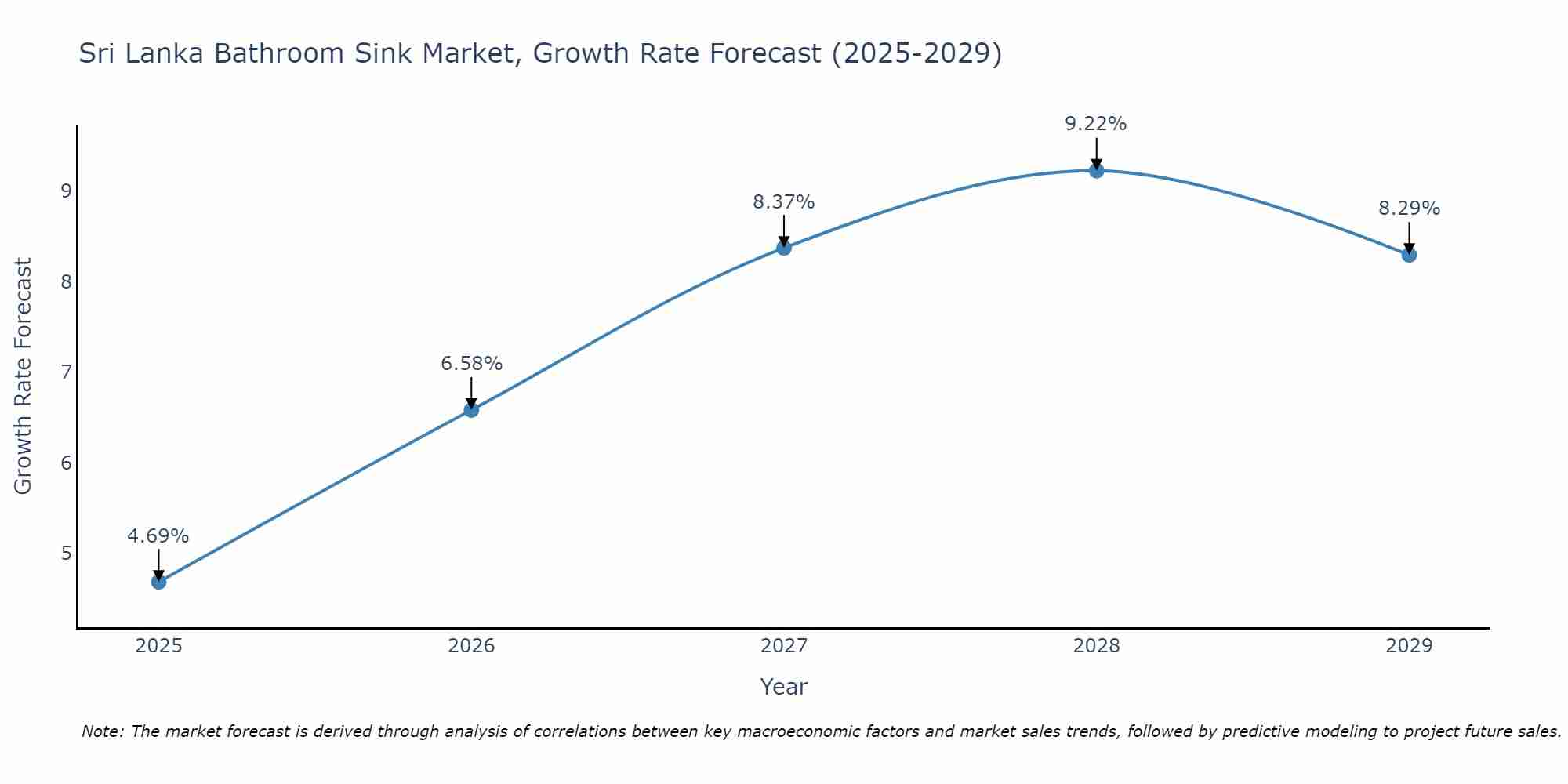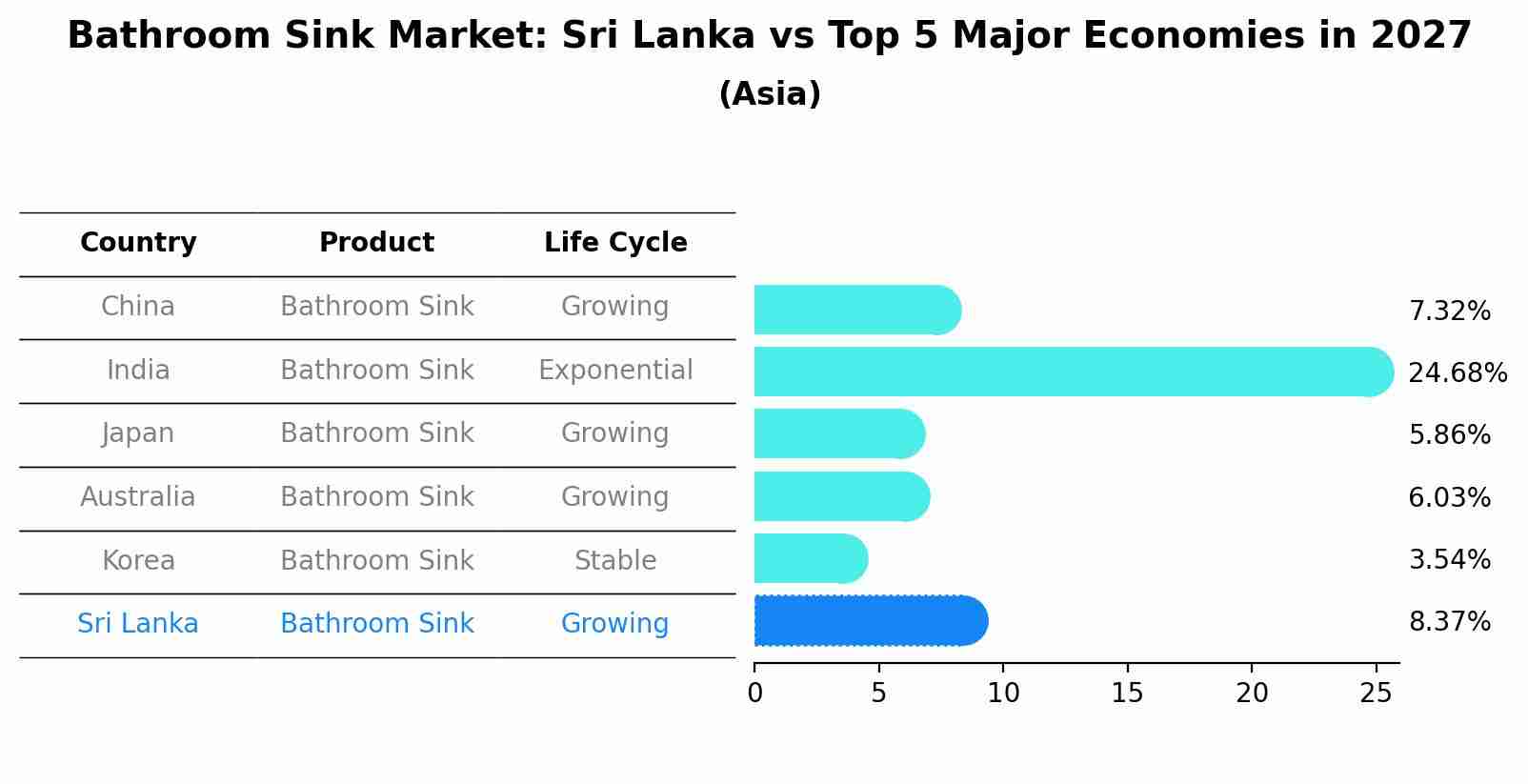Sri Lanka Bathroom Sink Market Outlook | Size, Forecast, Industry, Share, Value, Growth, Companies, COVID-19 IMPACT, Trends, Revenue & Analysis
| Product Code: ETC375091 | Publication Date: Aug 2022 | Updated Date: Apr 2025 | Product Type: Market Research Report | |
| Publisher: 6Wresearch | No. of Pages: 75 | No. of Figures: 35 | No. of Tables: 20 | |
Sri Lanka Bathroom Sink Market Size Growth Rate
The Sri Lanka Bathroom Sink Market is projected to witness mixed growth rate patterns during 2025 to 2029. The growth rate begins at 4.69% in 2025, climbs to a high of 9.22% in 2028, and moderates to 8.29% by 2029.

Bathroom Sink Market: Sri Lanka vs Top 5 Major Economies in 2027 (Asia)
The Bathroom Sink market in Sri Lanka is projected to grow at a growing growth rate of 8.37% by 2027, highlighting the country's increasing focus on advanced technologies within the Asia region, where China holds the dominant position, followed closely by India, Japan, Australia and South Korea, shaping overall regional demand.

Sri Lanka Bathroom Sink Market Overview
The bathroom sink market in Sri Lanka is expanding due to the construction boom and the increasing focus on home renovation and modernization. The demand for aesthetically pleasing and functional bathroom sinks is rising as consumers seek to enhance their living spaces. Innovations in design and materials, such as the use of ceramics, glass, and stainless steel, are driving market growth. Additionally, the hospitality sector`s expansion and the development of luxury residential projects are contributing to the increasing demand for high-quality bathroom sinks.
Drivers of the market
The bathroom sink market in Sri Lanka is driven by the growth of the construction industry, with significant investments in residential and commercial building projects. The increasing demand for modern and aesthetically pleasing bathroom fixtures is propelling market growth. Additionally, the rising disposable income and changing lifestyle preferences of consumers are leading to higher spending on home renovations and improvements, including bathroom fittings. The availability of a wide range of designs and materials, along with innovations in sink manufacturing, is further boosting the market.
Challenges of the market
The bathroom sink market in Sri Lanka faces challenges related to competition from inexpensive imports, which often offer a wider variety of designs and materials. Local manufacturers struggle with high production costs and limited access to advanced manufacturing technologies, which affects their ability to compete on price and quality. Additionally, there is a lack of innovation and design diversity in the local market, which limits consumer choices. The market also faces issues related to the distribution and availability of products in rural areas, where demand is growing but logistics and supply chains are less developed.
Government Policy of the market
The Sri Lankan government promotes the bathroom sink market through policies that encourage local manufacturing and innovation in sanitary ware. Import tariffs on raw materials for sink production are lowered, while manufacturers receive tax incentives and subsidies for adopting environmentally friendly production methods. Additionally, government-backed trade fairs and expos provide platforms for local producers to showcase their products and expand their market reach.
Key Highlights of the Report:
- Sri Lanka Bathroom Sink Market Outlook
- Market Size of Sri Lanka Bathroom Sink Market, 2021
- Forecast of Sri Lanka Bathroom Sink Market, 2028
- Historical Data and Forecast of Sri Lanka Bathroom Sink Revenues & Volume for the Period 2018 - 2028
- Sri Lanka Bathroom Sink Market Trend Evolution
- Sri Lanka Bathroom Sink Market Drivers and Challenges
- Sri Lanka Bathroom Sink Price Trends
- Sri Lanka Bathroom Sink Porter's Five Forces
- Sri Lanka Bathroom Sink Industry Life Cycle
- Historical Data and Forecast of Sri Lanka Bathroom Sink Market Revenues & Volume By Product for the Period 2018 - 2028
- Historical Data and Forecast of Sri Lanka Bathroom Sink Market Revenues & Volume By Under-mount Sinks for the Period 2018 - 2028
- Historical Data and Forecast of Sri Lanka Bathroom Sink Market Revenues & Volume By Top-mount Sinks for the Period 2018 - 2028
- Historical Data and Forecast of Sri Lanka Bathroom Sink Market Revenues & Volume By Pedestal Sinks for the Period 2018 - 2028
- Historical Data and Forecast of Sri Lanka Bathroom Sink Market Revenues & Volume By Vessel Sinks for the Period 2018 - 2028
- Historical Data and Forecast of Sri Lanka Bathroom Sink Market Revenues & Volume By Integrated Sink and Countertops for the Period 2018 - 2028
- Historical Data and Forecast of Sri Lanka Bathroom Sink Market Revenues & Volume By Semi recessed Sinks for the Period 2018 - 2028
- Historical Data and Forecast of Sri Lanka Bathroom Sink Market Revenues & Volume By Wall-mounted Sinks for the Period 2018 - 2028
- Historical Data and Forecast of Sri Lanka Under-mount Sinks Bathroom Sink Market Revenues & Volume By Washplane Sinks for the Period 2018 - 2028
- Historical Data and Forecast of Sri Lanka Bathroom Sink Market Revenues & Volume By Application for the Period 2018 - 2028
- Historical Data and Forecast of Sri Lanka Bathroom Sink Market Revenues & Volume By Residential for the Period 2018 - 2028
- Historical Data and Forecast of Sri Lanka Bathroom Sink Market Revenues & Volume By Non-residential for the Period 2018 - 2028
- Sri Lanka Bathroom Sink Import Export Trade Statistics
- Market Opportunity Assessment By Product
- Market Opportunity Assessment By Application
- Sri Lanka Bathroom Sink Top Companies Market Share
- Sri Lanka Bathroom Sink Competitive Benchmarking By Technical and Operational Parameters
- Sri Lanka Bathroom Sink Company Profiles
- Sri Lanka Bathroom Sink Key Strategic Recommendations
Frequently Asked Questions About the Market Study (FAQs):
- Single User License$ 1,995
- Department License$ 2,400
- Site License$ 3,120
- Global License$ 3,795
Search
Related Reports
- ASEAN Bearings Market (2025-2031) | Strategy, Consumer Insights, Analysis, Investment Trends, Opportunities, Growth, Size, Share, Industry, Revenue, Segments, Value, Segmentation, Supply, Forecast, Restraints, Outlook, Competition, Drivers, Trends, Demand, Pricing Analysis, Competitive, Strategic Insights, Companies, Challenges
- Europe Flooring Market (2025-2031) | Outlook, Share, Industry, Trends, Forecast, Companies, Revenue, Size, Analysis, Growth & Value
- Saudi Arabia Manlift Market (2025-2031) | Outlook, Size, Growth, Trends, Companies, Industry, Revenue, Value, Share, Forecast & Analysis
- Uganda Excavator, Crane, and Wheel Loaders Market (2025-2031) | Strategy, Consumer Insights, Analysis, Investment Trends, Opportunities, Growth, Size, Share, Industry, Revenue, Segments, Value, Segmentation, Supply, Forecast, Restraints, Outlook, Competition, Drivers, Trends, Demand, Pricing Analysis, Competitive, Strategic Insights, Companies, Challenges
- Rwanda Excavator, Crane, and Wheel Loaders Market (2025-2031) | Strategy, Consumer Insights, Analysis, Investment Trends, Opportunities, Growth, Size, Share, Industry, Revenue, Segments, Value, Segmentation, Supply, Forecast, Restraints, Outlook, Competition, Drivers, Trends, Demand, Pricing Analysis, Competitive, Strategic Insights, Companies, Challenges
- Kenya Excavator, Crane, and Wheel Loaders Market (2025-2031) | Strategy, Consumer Insights, Analysis, Investment Trends, Opportunities, Growth, Size, Share, Industry, Revenue, Segments, Value, Segmentation, Supply, Forecast, Restraints, Outlook, Competition, Drivers, Trends, Demand, Pricing Analysis, Competitive, Strategic Insights, Companies, Challenges
- Angola Excavator, Crane, and Wheel Loaders Market (2025-2031) | Strategy, Consumer Insights, Analysis, Investment Trends, Opportunities, Growth, Size, Share, Industry, Revenue, Segments, Value, Segmentation, Supply, Forecast, Restraints, Outlook, Competition, Drivers, Trends, Demand, Pricing Analysis, Competitive, Strategic Insights, Companies, Challenges
- Israel Intelligent Transport System Market (2025-2031) | Strategy, Consumer Insights, Analysis, Investment Trends, Opportunities, Growth, Size, Share, Industry, Revenue, Segments, Value, Segmentation, Supply, Forecast, Restraints, Outlook, Competition, Drivers, Trends, Demand, Pricing Analysis, Competitive, Strategic Insights, Companies, Challenges
- Uganda Precast and Aggregate Market (2025-2031) | Strategy, Consumer Insights, Analysis, Investment Trends, Opportunities, Growth, Size, Share, Industry, Revenue, Segments, Value, Segmentation, Supply, Forecast, Restraints, Outlook, Competition, Drivers, Trends, Demand, Pricing Analysis, Competitive, Strategic Insights, Companies, Challenges
- Australia IT Asset Disposal Market (2025-2031) | Strategy, Consumer Insights, Analysis, Investment Trends, Opportunities, Growth, Size, Share, Industry, Revenue, Segments, Value, Segmentation, Supply, Forecast, Restraints, Outlook, Competition, Drivers, Trends, Demand, Pricing Analysis, Competitive, Strategic Insights, Companies, Challenges
Industry Events and Analyst Meet
Our Clients
Whitepaper
- Middle East & Africa Commercial Security Market Click here to view more.
- Middle East & Africa Fire Safety Systems & Equipment Market Click here to view more.
- GCC Drone Market Click here to view more.
- Middle East Lighting Fixture Market Click here to view more.
- GCC Physical & Perimeter Security Market Click here to view more.
6WResearch In News
- Doha a strategic location for EV manufacturing hub: IPA Qatar
- Demand for luxury TVs surging in the GCC, says Samsung
- Empowering Growth: The Thriving Journey of Bangladesh’s Cable Industry
- Demand for luxury TVs surging in the GCC, says Samsung
- Video call with a traditional healer? Once unthinkable, it’s now common in South Africa
- Intelligent Buildings To Smooth GCC’s Path To Net Zero













